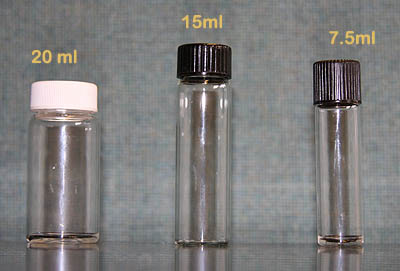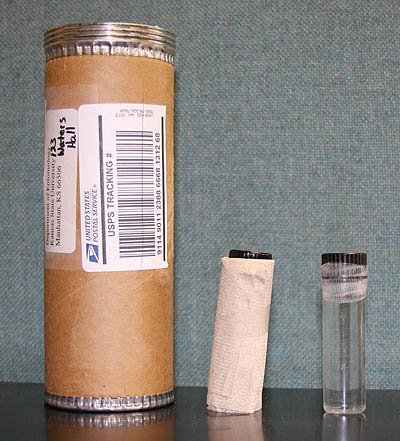Instructions for Mailing Samples to the Insect Diagnostic Lab
Your local K-State Research and Extension office should have supplies on hand for submitting specimens, including glass screw-top insect vials, mailing canisters, and submission forms (Figures 1–3). Shipping materials will not be returned. Supplies for the Extension office are available upon request and can be delivered in two to three weeks.
Large insects, such as beetles, moths, or butterflies, should be killed by placing them in a freezer for 24 hours. Keep them dry and ship in a crush-proof box cushioned with tissue paper. Do not use cotton because legs and antennae will tangle and break. Insects taped to index cards or mailed loose in envelopes arrive in pieces and cannot be identified. Never mail live insects.
For small or soft-bodied specimens that must be examined physically in the laboratory, place the insect in a vial of vinegar or rubbing alcohol to kill and preserve it. This procedure is critical for aphids, gnats, and many immature insects, and reduces shriveling and distorting. Shriveled, broken, or decomposing specimens cannot be identified. Do not fill the vial all the way to the top. Leave a small amount of air space to allow for expansion in case the sample becomes hot during shipping. Please note: Do not store specimens in water. Water does not preserve specimens and can lead to serious degradation of the specimen.
- Vinegar preserves the softness of the specimen, but prolonged submersion (>3 days) with hot summer temperatures often causes the specimen to bloat and disintegrate during subsequent manipulation. Wings of moths become descaled and soft insect bodies become discolored. The advantage of shipping in vinegar is that there is no shipping restriction and larger volumes can be used safely.
- Rubbing alcohol is a preferred preservative over vinegar. The rubbing alcohol belongs to Class 3 of hazardous materials and can be shipped in the amount of less than 30ml (1oz) under the Small Quantity Exception Rule as outlined in these documents (applies also to UPS, FedEx ground and USPS according to 49CFR):
- USPS Small Quantity definition: http://pe.usps.com/text/pub52/pub52c3_015.htm#ep898574
- IMPORTANT! When rubbing alcohol is used as a preservative, each mail piece that qualifies to be sent under the small quantity provision must be clearly marked on the address side with the following words: “This package conforms to 49 CFR 173.4
When shipping insects in any liquid, make sure the container lid is on tight and secure the cap with tape. Wrap the vial in a paper towel and place within a zip-sealing plastic bag. Put bag in a box or a mailing tube filled with enough absorbing packing material to soak up the liquids in case of a spill. Make sure the vial is not loose and cannot break if the package is accidentally dropped. Enclose the diagnostic form , seal package, and ship by surface mail.
Figures 1-3:



Fig. 1. Vials supplied by the Extension office showing approximate volumes. Fig. 2. A mailing tube next to the wrapped vial in the paper towels and a vial cap secured with a tape. Fig. 3. Enclosed in the tube is the submission form and absorbent cushioning material.